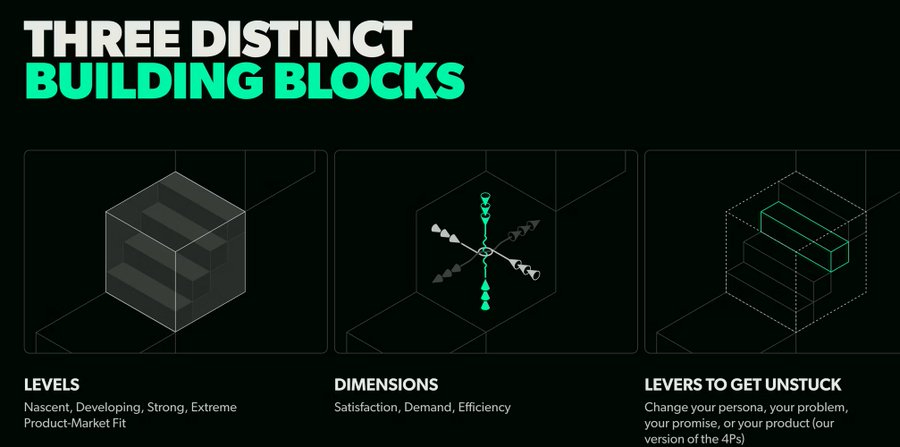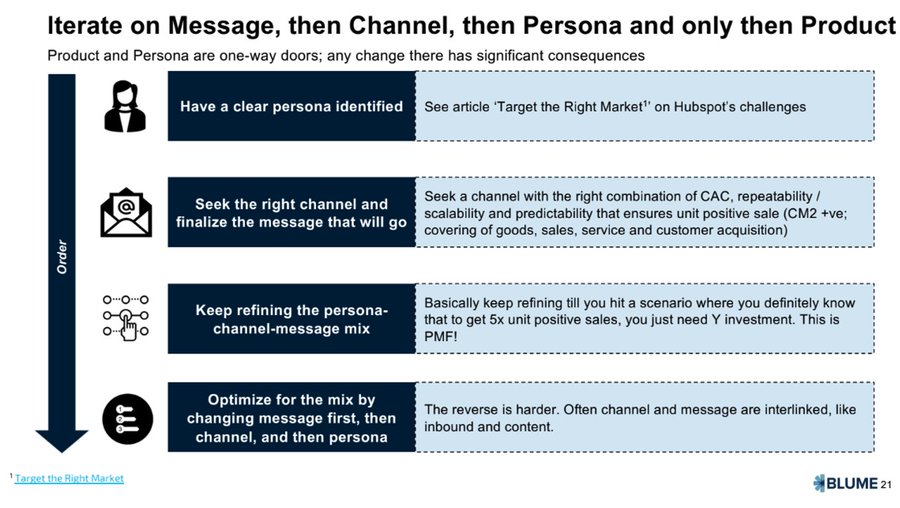So, two new products launched last week. One was Airchat. But this isn’t about that. This post is the about the second one, First Round’s PMF Method! It is essentially a framework, and a program for founders. The framework helps B2B companies with a top-down motion systematically work towards product-market fit (PMF hereafter). They opened up the framework in a post (and in a Lenny’s podcast episode) but much of the secret sauce is being reserved for a 3-month program they are running for 20 or so, B2B founders starting end-May. Given my obsession with PMF (I am working on a generalisable framework / playbook for founders to iterate towards PMF) and prior writings, I got shared links to the PMF Method by multiple people! Given how little high-quality content gets generated on PMF, I was excited as well to see this. Over the weekend, I dived in, reading about the framework / program as well as listening to the podcast. Here is my take on the PMF Method and the framework.
Firstly, the framework looks well thought-through. The overall content and course programming looks top notch as well. Having digested this over the past few hours, I do feel this is *perhaps the the most important advance in PMF lore and craft since Eric Ries’ Lean Startup*. Now to a quick review.
Only for B2B sales-led or top-down motion startups
I like the fact that it is focused on B2B Sales-led startups specifically. SaaS is the Physics of the venture world, and over time, the field has evolved a rich set of metrics (magic number, rule of 40 etc) and playbooks to guide the SaaS founder. Even when I was doing my research – both readings and my own PMF Convos, I got the impression, and views that if you are in B2B SaaS and have a top-down motion, then PMF can be systematically worked toward.
I remember reading a transcript of David Hsu’s (Retool) onstage chat with Sequoia’s Brian Schreier, where Hsu mentioned: “So I think of the B2B SaaS world, actually, the way I think about it is there is always a path to a product/market fit to some extent in the sense that it’s almost like a chess game…there’s like eight moves you can play where you will find product/market fit somehow. Now the question is how do you make sure you’re on those eight moves? That’s the challenging thing. But I think being sales-driven, being customer-driven are probably the two main things, especially being outbound sales driven.”
Affinity’s Shubham Goel in my PMF Convo with him, said, “I feel product-market fit, especially, people think it’s more mysterious than it is, is how I would describe it. I think that you can sort of follow the steps that I talked about, or I’m sure there’s another way to do it; this is the one that I’ve found. But if you pick a space and certain customers or prospects that there’s a way to engineer yourself to product market fit, or at least the likelihood is not like 1% or 4% or 3%, whatever the numbers that people say as startup dying rates, I think there’s a 30 – 40% chance you’re able to figure it out.”
Why is B2B top-down PMF easier and B2B PLG or B2C harder? Primarily because in B2B top-down startups you are directly connected to the customer, and the feedback flows directly to you, without anyone intermediating the feedback or any delay in receipt of feedback. Also there are fewer customers and you get to track feedback from every one of them. You can thus iterate faster to incorporate the feedback. In B2B PLG and B2C, you interact with the customer through ads, and there are just too many customers for you to meaningfully assess and determine the exact issue. Not saying it can’t be done, but it a tad harder.
PMF Method – their framework
The framework helps startups navigate across four levels of PMF – level1 (nascent) to level2 (developing) to level3 (strong) to level4 (extreme) of pmf, stressing different dimensions of demand, satisfaction or efficiency, depending on your stage, and using one of the four levers of persona, problem, promise and product to unlock or pivot. To summarise:
- 4 levels of PMF – Nascent, Emerging, Strong, to Extreme.
- 3 dimensions – Demand, Satisfaction, Efficiency.
- 4 levers – Persona, Problem, Promise (Positioning), Product.

I like the broad framework, especially the 3 dimensions of Demand, Satisfaction, Efficiency and what to stress on at each of the different PMF Levels you are at. I found it interesting that they mentioned how you have to trade off one for the other at different stages. At the first stage satisfaction scores above efficiency, while at stage three, you have to look at efficiency etc. This is the best kind of insight, one which when you read seems blindingly obvious.
I liked that they shared benchmarks for each level like typical ARR range, what range of engagement (Churn, NRR etc.,) and efficiency metrics (e.g., Magic Number). This is likely to come in very handy for founders.
The emphasis on repeatability was welcome. They call repeatability the holy grail on the hunt to PMF. They aren’t wrong. There weren’t too many details on the mechanics of repeatability – this is understandable as this post only covered the details of the intro session.
The four levers to pull on as you get unstuck on the path to PMF (persona, problem, promise and product) was a useful mental model. And here is the first of my quibbles with the piece. Essentially these levers are broadly to help you pivot. And if so, then these four levers are not MECE (mutually exclusive, collectively exhaustive) to getting the job done. There are three broad pivots – – pivot the market keeping the product constant (or some aspects of it). This is the most common pivot. (e.g., Ironclad in their piece) – pivot the product, keeping the market constant (e.g., Lattice) – pivot the product and market (e.g., Shippo) If so, then the four levers are insufficient for the first – pivoting to a new market. Inherent in that is figuring out a new or side channel for the new persona you are targeting. Or de-emphasising a new channel. For instance in Ironclad’s case, moving to an established category meant they had enough search volume to run SEM ads, and develop a SEO playbook. So channel is a key lever as well. Here is how I address it in my piece on achieveing PMF.

I have two other minor quibbles; these are minor personal takes, and don’t detract from the overall piece. One was on the fact that they see the four PMF types as levels. An alternate approach I prefer is to look at every stage of co as a continuum of PMF strength from weak to strong, or soft to hard. Sequoia recently published a framework where they categorise PMF intensity across three types (‘hair on fire’ or the most intense, then ‘hard facts’ and finally ‘future vision’). Unlike levels these are types of PMF, and is an interesting alternate framework, also useful because depending on the kind of PMF you have, you may need to spend more on GTM.
A good alternative to seeing PMF as level-based is to see it as a set of differently-sized knobs and dials that you need to fiddle with – each knob and dial standing for different choices and tradeoffs: product features, channel spends, person decisions etc., – to achieve high fidelity or PMF. If so, at every stage of the co you can have strong PMF or weak PMF (or hard and soft). Per me, PMF can be strong or hard at each level of the co, unlike here where every early stage co is nascent and every late-stage unicorn co is extreme. We know things aren’t that binary.
Finally, I didn’t see too much usage of the word iteration here. In my PMF notebook, the one clear pattern I see with startups who achieved PMF fast was rapid iteration. Perhaps it is stressed in another session.
Wrap
Overall, I think this framework and program is a very well-thought out and put together body of work. The effort shows, and it is impressive that First Round Capital was able to support the six-member team and invest in the content and program development process for a year (the founder interviews are exceptional pieces of content). In the podcast with Lenny, Todd Jackson mentioned that they have sourced zoom recordings of founder sales pitches and extracted highlights specific to each concept. This is impressive. While First Round doesn’t create as much content as an A16Z, the content and impact tends to be spiky like here.
For Indian founders in the B2B SaaS space, and with a cross-border / enterprise / topdown motion, do consider applying here.
If you want to get familiar with the First Round PMF Method, then I would recommend listening to the Lenny podcast with Todd Jackson first. It is a good lucid introduction to the framework. Subsequently, you can review the post.
***
If you enjoyed this piece, do consider checking out my pieces on PMF
Link to my pieces on PMF
Link to my PMF framework
Link to my PMF Convos
